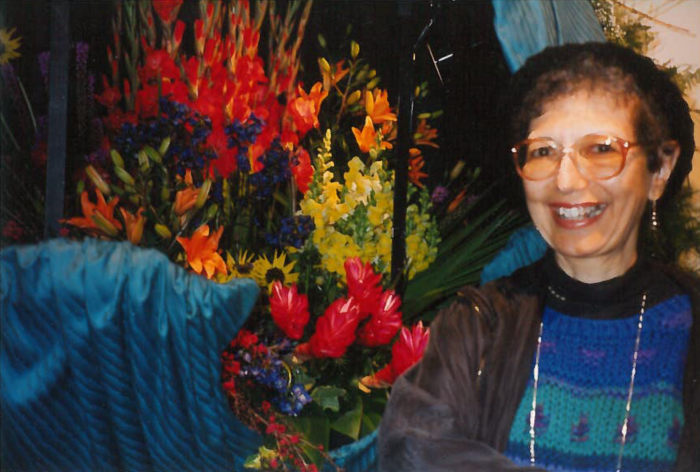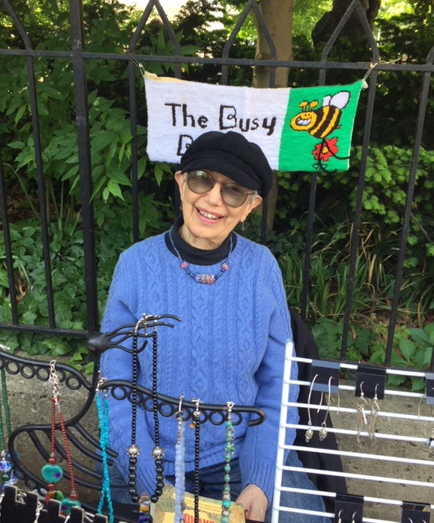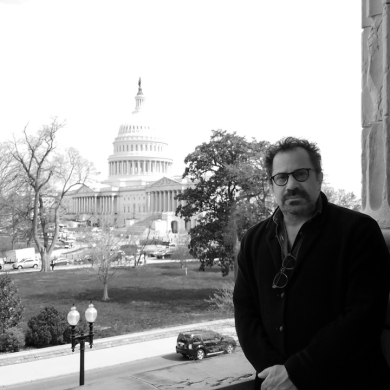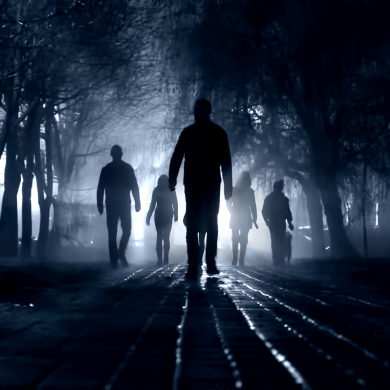Published Date: 06-26-19
By Justin Sanders
Spotlighting the vital contributions of the creative community is part of our mission at CreativeFuture – especially when those contributions might not be so clear to everyone else. That’s why we’re delighted to now present 88-year-old Marilyn Kagan, whose lifetime of creative output represents the epitome of flying under the radar.
Now a happy, jewelry-designing, Scrabble-playing retiree in Providence, Rhode Island, Kagan used to work as an architect in Philadelphia. When you hear the word “architect,” you might imagine a designer of ornate music halls, towering skyscrapers, or mighty bridges. And, you would be only half right, because architects lend their creativity to all kinds of other important projects as well – most of which you likely never think about at all.
Did you know, for instance, that architects design sewers? You might be able to imagine life without a music hall, but can you imagine if there weren’t architects who were willing to design the pipes that transport human waste from one place to another? It’s hard to think of a creative contribution with more measurable value to a society, and Kagan was a creator of many such contributions. During her long tenure with the Philadelphia Water Department, she helped design essential urban infrastructure ranging from sewers to offices, bathrooms, shower rooms, and other features for a public utility that was absolutely essential to the functioning of one of the world’s great and historic cities.
In short, you can’t have the parts of a city that get sung about – the museums and the squares and the halls and the towers – without the unsung parts made by people like Marilyn Kagan.
This is her story.

MAPPING HER DESTINY
Before Marilyn Kagan was an architect in Philadelphia, she was a little girl in Providence, Rhode Island, growing up in a three-story apartment building. Her father ran a grocery store before eventually becoming an insurance agent. Her mother was a homemaker.
As a youngster in grammar school, she would sketch trees on her math papers. As a teenager, she dabbled in oil painting. After high school, she studied to be a nursery school teacher at the University of Rhode Island, but it didn’t stick. It was what was considered “women’s work” in those days, Kagan told CreativeFuture, and she wanted more.
One day, Kagan’s downstairs neighbor told her that the United States Army Map Service was hiring cartographers at their Rhode Island office. Kagan, who was working at a post office station in the local drug store at the time, had never drawn a map before, but she had taken life drawing courses at the famous Rhode Island School of Design (RISD), and “if you can draw the human body, you can draw anything,” she said. And besides, the job “sounded interesting.”
The office was located in a shipyard that once built Liberty Ships for World War II. There, Kagan was given a test. They handed her an image defined by many blue contour lines and told her to draw over it in black. She had never drawn in ink before – “just in charcoal and in pencil” – and she smudged the final line. “I thought, ‘Oh no, I wasted an hour here,’” she said, and she went home, dejected. But, she got the job anyway, and after waiting a year for security clearance, she started working.
As a cartographer for the Army, Kagan spent most of her time mapping China, a vast geographical expanse whose rugged terrain, in a time before GPS, was largely unknown. The year was 1952, and mapmaking was done by using a device known as a stereoscope. It was a machine with two lenses – one for each eye. Looking through the lenses, Marilyn would insert two photographs of the same spatial plane and overlay them until “information popped up” in 3-D. “That’s how you could tell where the roads were, and the rivers,” she said. “You looked at that and then you looked at your map in progress, and you drew.”
Though she enjoyed the work, Marilyn felt a need to get away from Providence. She had heard about a mapmaking job in the private sector, in Philadelphia, at a company called Aero Service Corporation. Almost on a whim, she traveled there and applied for the job. That’s what you did to get jobs in those days – you went to where the job was and you applied in person, even if it was hundreds of miles away from where you lived. When Kagan’s parents heard of her decision to leave Providence, they were “very upset,” she said. “I was a very quiet person and my family didn’t expect that. Women stayed home until they married then, but I wasn’t about to stay home. Or get married.”
At Aero, Kagan’s cartography team worked from photographs taken by airplanes that were equipped with magnetometers. The planes would fly over uncharted territories of the world at altitudes as low as 500 feet, probing for untapped reserves of coal and other energy resources. Some of the regions were so remote, they were inhabited by primitive peoples that were entirely removed from modern civilization. Sometimes these natives would hurl spears at the planes. Safe and sound back in a Pennsylvania office, Kagan just took the visual information given to her, and made maps.
DRAWING A NEW PATH
Over time, Kagan would shift from mapping strange and distant China to the local geography of Philadelphia. She changed employers, then changed again, eventually winding up at the city’s own Redevelopment Authority office, where she would spend the ‘60s charting areas being assessed for urban renewal. Sometimes, the job required her to go out in the field and inspect the buildings she was mapping to see which ones were deteriorating beyond the point of no return. In this way, she “saw a lot of buildings in and around the city,” she said – which led her to a realization.
“I thought I could do better,” Kagan said. “I really wanted to be part of the architecture of the city.”
And so, with a new goal of transitioning from cartography to architecture, Kagan called up Philadelphia’s Drexel University and inquired about architectural drawing and history classes. “They said I could matriculate,” she said, “so I did. I just went.”
By now, it was the late 1960s. The Civil Rights movement had changed many things, but gender inequality was not one of them – Kagan was the only woman in her class. Fortunately, her fellow classmates were nice family men who, like her, had jobs to work during the day then “went to school at night because they wanted to better themselves,” she said. Unfortunately, her professors were another story. They were threatened by having a woman in the architecture program. One of them polled the male students in Kagan’s class to see if they were comfortable working with a woman on class projects (they were fine with it). Another had a nasty habit of flat-out lying to Kagan about what was needed for his class, tricking her into showing up each day with the wrong materials. His sabotage was discouraging enough to drive her away from the program for two years – until she heard that he had moved on from Drexel and could return to complete her degree.
She endured this blatant sexism and emerged at the top of her class. For her final student project, Kagan designed a kibbutz in Israel with a system of steel-reinforced concrete bases to prevent its buildings from sinking into the mud. This application of her creative talent toward bettering the functionality of a public space was a sign of things to come.

BUILDING A CAREER
While still finishing school at Drexel, Kagan took the City of Philadelphia exam for architects, got the highest score of anyone, and was eventually hired to work in the architectural section of the municipal Water Department. However, the new job was contingent on funding from the Environmental Protection Agency. And so, while waiting for the grant to arrive, Kagan went to work for a different section of the Water Department: the Sewer Design team. Yes, even sewers have to be designed by someone, and for a while, Kagan, along with a team of engineers, was one such person.
One of the sewers Kagan worked on extended beneath Wolf Woods in the Philadelphia Zoo, quietly serving its purpose as the animals grazed above. At the time, there happened to be a sewer being built right in front of Kagan’s apartment, its innards exposed for all the world to see. Every night after work, she would pause on her way home to observe how the crew shored and sheathed the earth to keep towering piles of dirt at bay while they worked, and how “they had the pipes of one level going into the pipes of another level.” Even the lowly sewer, made to transport human waste from one place to another, had hidden depths and a surprising complexity. She was building something good and necessary, and no one could say she wasn’t part of the architecture of the city at last.
Eventually, the EPA funding came through, and Kagan could move into the architectural position she had been hired for. For the next 20 years, she designed structures utilized by the Water Department, envisioning nooks and crannies that few people think of when they imagine a functioning cityscape. Pumping stations. Locker rooms for construction workers. Chemical laboratories for water purification. Bathrooms for the disabled. Her contributions were not swooned over as one might the Philadelphia Museum of Arts, the Fisher Fine Arts Library, and other local hotspots found in the tourist books. But, they were the unassuming connecting points between these gems, like the tendons of a healthy body.
For two decades, Kagan spent most of her waking hours in a workspace measuring 14 square feet. It was all she needed, and she loved being there. “I would hum,” she said. “I would sing over the drafting table. You always had a drafting table in front of you, a flat table in back of you, and a good lamp so you could see what you were doing.” All that and pencils, of course. Lots and lots of pencils. Where in mapping she had used ink to make weighted lines, architecture was all about shading, using charcoal and graphite to evoke elevation, highlight building facades, and etch in the contours of the given structure’s surrounding land, the earth itself, the basis of its foundation.
YOU CAN GO HOME AGAIN
Two rivers frame Philadelphia, the Delaware and the Schuykill, creating a bruising humidity during the long East Coast summers. By the time Kagan was 60 years old, this relentless weather pattern had taken its toll. “My hands were arthritic and it was getting difficult to hold the pencil,” she said. Her pension had kicked in. The time had come to retire.
She moved back to her hometown “because it doesn’t have the humidity,” Kagan said. “My hands don’t bother me at all in Providence.” She needed to keep her fingers nimble for her newest passion, the meticulous assemblage of semi-precious stones, art glass, and sterling silver – also known as jewelry- making. She began the hobby in Philadelphia, and more than twenty-five years later, she’s still at it. In her 70s, she enrolled again at RISD, earning an interior design certificate there. As always, she did it for practical reasons – the paperwork was her ticket to sell jewelry on campus as an alumna, at various RISD craft shows.
Today, in her late 80s, Kagan has no car and walks everywhere. She attends two monthly book clubs, holds season tickets to two theater groups and a chamber music series, and makes the trek to Philly five times a year to attend Philharmonic concerts. And every Saturday, she joins a group for a rousing game of Super Scrabble, played on a board the size of a card table. Though her days as an architect are behind her, Kagan, whose jeweler moniker is “The Busy Beader,” has never had a problem staying active.

AND THEN THERE’S THIS
In the 1980s, Kagan was the head of the Soviet Jewry committee at her synagogue in Philadelphia. One year, the committee decided to adopt a Soviet family and help them get settled in America. Kagan met the family’s plane at the airport and brought them to their new apartment, which had been furnished and loaded with food. They cried when they saw it.
“The family and I adopted each other, and we’re still in contact to this day,” she said. “The youngest, a girl, was seven when she came up that airport stairway, and now she’s the mother of two sweet young boys.”
This was the final story Kagan told CreativeFuture in the process of writing this piece. She tossed it in at the very end of a multi-part interview cycle, via email, and only after some prodding on our end. In retrospect, it is the perfect metaphor for her long, illustrious creative life: She chose to devote her ample creative gifts to a selfless line of work that was free of flash or public recognition. As a woman in her field, she encountered hostility and betrayal that would have stopped many people in their tracks. She exceled anyway, and never thought twice about it. Excelling is just what Kagan does.
“I kept going because I had my goals,” she said. “I’m a Scorpio. I can be vicious and I can be strong and I can be loyal – and if you cross me, you’re dead. But if you’re my friend? I would die for you.”
Time and again, Kagan bucked the odds and prevailed in a male-dominated world. “I didn’t consider myself brave. I just considered myself doing my thing, and nobody was going to stop me from doing my thing,” she said. “I always just wanted to solve problems.”



